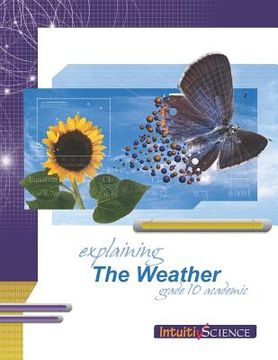Explaining the Weather: Student Exercises and Teacher Guide for Grade Ten Academic Science (en Inglés)
Reseña del libro "Explaining the Weather: Student Exercises and Teacher Guide for Grade Ten Academic Science (en Inglés)"
So you want to predict the weather? We can do that!We are all visual learners. So, just like all of the IntuitivScience books, you will start by learning to use simple, intuitive diagrams to represent three basic theories.You are probably already familiar with the particle theory of matter.From there, you will learn to use the concept of an air parcel, to predict and explain the behaviour of air.Finally, you will build upon these two theories together to describe common weather events.Using pictorial representations of these three theories, you will learn how to calculate atmospheric pressure, energy, temperature, mass and other quantities related to weather. As you become more adept at drawing these specialized pictures of the earth's atmosphere, you will learn how to use these theoretical descriptions to explain and predict the weather around you.For all of the labs and practical activities, you will use the PEOE (Predict, Explain, Observe, and Explain) model of science investigations. After you frame your question, you will provide your best prediction, and explain your thinking, using both sentences and diagrams. When the experiment is over, you will record your observations, and then fix your earlier explanation You will use your diagrams to interpret and predict the weather.Your knowledge and understanding will be probed in Daily Quizzes.At the end of the unit, you will be given a five day independent project to demonstrate your ability to conduct your own investigation. The quality of your arguments is the most important aspect of communication in this chapter. Your arguments must consist of sentences, organized into paragraphs, and supported by diagrams or other representations.As in all of the IntuitivScience series, diagrams are an important mode of expression. The diagrams provide the student with tools to analyze the most important forces that influence Earth's weather. Every two-page student exercise uses easy-to-learn diagrams as the building blocks of understanding.Parents and teachers, you get one half of the book! Each two-page student activity is accompanied by a two-page teacher / parent guide, that provides solid pedagogical supports, recipes, and methods of presentation.The book is subdivided into three major sections. Each section will take a little more than one week to complete.Basic structure of the atmosphere and the factors that shape it. Foremost is the particle nature of the gases that make up the atmosphere, and the forces that act upon the gases. Also included is the role of water and its changes of state in the energy economy of the atmosphere.The circulation of air parcels as they absorb and release energy from the sun. This fundamental motion is simple, but can be used to explain complex events like cloud formation, chinooks, and warm and cold fronts.The effect of the spinning of Earth upon the motion of circulating air masses. The winds that we experience are shaped more by the Coriolis effect than by thermal effects. This counter-intuitive idea is one of the more difficult ideas to learn.At the end of the formal exercises, students are invited to undertake a five day structured research project on a weather event of interest to them

